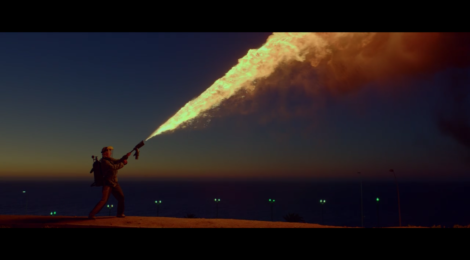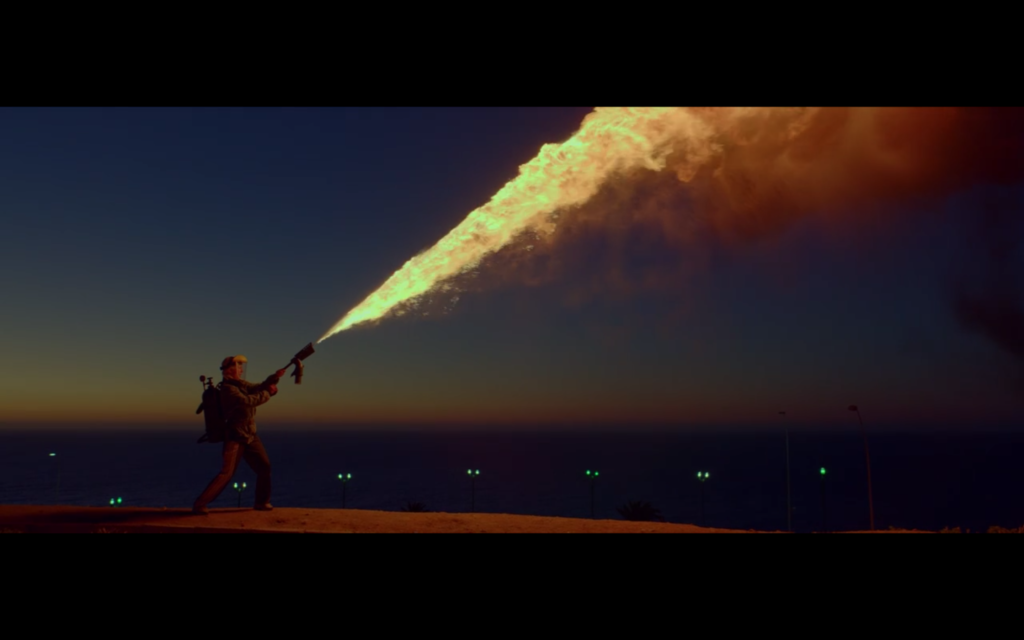
Ema’s Mise en Abyme: Music Video Aesthetics and Women in Reggaeton
by Ellen Bishell*
For a scholar of music video, to give a short take on Pablo Larraín’s Ema (2019) is not an easy feat. It is simply not possible to apply the standard technique of identifying what, after multiple re-watches, is most visually and musically impactful. After all, the advanced cinematography and use of montage that are characteristic of music video are here drawn out across a ninety-minute cinematic tour de force of love, lust, and loss, of manipulation and mystification, of dance and desire, all brought to a vehement surface through fire, flamethrowers, arson, and, most importantly, reggaeton.
The lead eponymous character is an elusive yet exhibitionistic reggaeton dancer who harnesses the power of music and movement for her own personal agenda. Navigating the breakdown of her irreconcilable toxic marriage to choreographer Gastón after having returned their adopted son, Polo, to the orphanage, reggaeton is both her catharsis and her course for getting him back. Yet this underlying narrative of the film is somewhat eclipsed by its heavy investment in music video style aesthetics. Standing in sharp contrast with the filming of the director’s latest biopic Jackie (2016), where long takes, vintage lenses, and close-ups give a visual fidelity to real life events, the production of Ema rather began with reggaeton. Larraín’s directorial decisions were largely guided by Nicolas Jaar’s pre-composed musical score, a part melancholic, part danceable, yet wholly dynamic collection of tracks underscored with dembow beats and heavy, powerful bass lines. As Larraín tells us in a recent interview, adapting – sometimes improvising – the tone of the film and its choreography according to Jaar’s exquisite music meant ‘working with the unexpected’, a practice that is thought among ethnomusicologists to be at the very root of reggaeton itself (see, for example, Marshall 2009).
The result of such improvised filming processes could have quite easily been confusing and unwieldly. Indeed, some critics conceive Ema as having ‘no story at all’, its fragmented, somewhat distortive montage rendering it ‘an electrifying watch that doesn’t quite connect’. Yet woven into these multiple levels of chaos there is something more critical to be explored in its artistic articulation. This is to say, though the ‘main’ narrative of Ema’s mission to take back her son becomes engulfed by violent visuals and mesmerising music, these aesthetics tell a story to the beat of their own drum. Ultimately, the totality of complex, rhythmic, dynamic, and dramatic mises en scènes is a mise en abyme – one that tells the equally complex, rhythmic, dynamic, and dramatic story of women’s presence in reggaeton.
It makes sense for a ‘story’ about reggaeton, as it were, to be told through the medium of music video. From the release of Daddy Yankee’s Gasolina in 2004 to the release of Luis Fonsi’s Despacito in 2017, music video has been the genre’s primary mode of circulation. Despite its unquestionable popularity across the Caribbean, Latin America, and indeed around the world, reggaeton has been widely criticised for its machista and heteronormative ideals, a view that is echoed in Gastón’s outburst of frustration in the film: ‘las mujeres se convierten en objetos sexuales…y el hombre es un puto macho…todo el tiempo está metiéndole el puño en el culo a las mujeres…y ese es el ritmo’. Yet Ema, for the most part, speaks to the recently increased, precarious yet persistent intervention of women in this historically male-dominated space. This is verbally captured by the trio of feisty female reggaeton dancers as their practice on a worn-down basketball court comes to an end. Upon noticing the simultaneously derogatory and objectifying gaze being cast over them by the people of the hills, it is made explicit: ‘¿Creen que lo hacemos por ellos? Lo hacemos por nosotras’.
This is the overriding message of the ‘neoperreo’ movement that has emerged in parts of Mexico, Argentina, and especially Chile in recent years. Chilean artist Tomasa del Real, whose Perra del futuro (2018) features heavily throughout Ema in both its original dembow beat and drawn out into hypnotic, almost unidentifiable fragmented motifs, is a leading figure of neoperreo. Shaking up the strict gender codes of traditional reggaeton, neoperreo emphasises that women are just as entitled to take centre stage in reggaeton as men. In recent months, similar claims to gender equality and women’s rights have put Valparaíso, in which Ema is set, on the viral map as a centre of radical feminism. The globally re-enacted performance of ‘Un violador en tu camino’ (A Rapist in Your Path) originated from a feminist collective in the city who took to the streets, chanting blindfolded before a police station to speak out against the numerous injustices imposed upon women by ‘El Estado opresor’, the ‘macho violador’. However, just as Larraín does not consider Ema to be a feminist film, per se, directed and produced as it is exclusively by men, neither does Tomasa del Real class neoperreo as a feminist subgenre. Rather, as she tells multimedia columnist Jennifer Mota, ‘it’s the opposite…I’m someone who enjoys reggaetón, and no one should really worry about someone having breasts or a penis’.
For del Real, the reality is that in reggaeton ‘the narratives change and let us deal with who we really are – even the dark parts’. And it is this reality that is adroitly depicted in Ema’s surreal audiovisual aesthetics. Rapid cross cutting between public and private spaces, dance scenes penetrated by flashes of neon colour, juxtapositions between extreme long shots and extreme close-ups, and audiovisual combinations working in constant conformance, complementation, and contestation arguably reflect the discursive uncertainty of what it means to be a woman expressing herself through reggaeton – and the turbulent journey she has taken to get there. They equally emulate the lawless disarray into which Ema’s life has seemingly spun, although her fiery displays of dance and seduction in fact hint at her role as choreographer of this apparent chaos.
In this interpretation of the ambivalence of a woman who expresses herself through reggaeton, there is one particular scene that merits attention. Following on from Gastón’s iconic besmirching of reggaeton music and the women who dance it, a choreographed performance among Ema and her dance troupe unfolds into a miniature music video clip in itself. To the sounds of sirens underscoring the introductory strums of Jaar’s REAL – the official soundtrack of the film produced under his pseudonym E$tado Unido – the clip begins from a Valparaíso rooftop. As the beat kicks in the group of dancers moves to the rhythm with force, the camera moving closer towards and around Ema so as to hold our gaze captive. The cross-cuts that follow are rapid, almost nonchalant, as if deliberately detracting from the film’s ‘plot’; from the rooftop to the church, and then from the beach to a balcony, the plot becomes simply about these women who have the power to take over the city and dance where they want. Time and place are manipulated, becoming malleable according to their desire and movement. Such a powerful presence is complemented here by cinematographic choices. Low-angle shots that pan around the circle of women render them the most important part of the viewing experience, backtracking dollies move according to where the women decide to go, and, arguably most significantly, long shots highlight the brilliance of fire that Ema releases from a flamethrower against the night sky.

So how might this scene fit into the wider context of the narrative? First, it is a reaction to Gastón’s verbal attack. In contrast to reggaeton’s central use of gender-strict call-and-response patterns – as we hear in Daddy Yankee’s Gasolina, the man ‘calls’ (a ella le gusta la gasolina) and the woman ‘responds’ (dame más gasolina) – these women are not what Félix Jiménez calls reggaeton’s ‘yes-girls’ (2009: 232). Rather, the powerful visuals of both their performance and audiovisual aesthetics elicit a power to fight back, to say ‘no’, again changing the narrative to work in their own favour. The significance of this scene also owes to the fact that it seems to embody the feel of the film as a whole. The frenetic filming and accompanying rhythms that guide both Larraín’s direction and Ema’s own journey are here condensed into a three-minute spectacle of ruthless resistance, rigour, and rampage. My final observation of this scene is its incorporation of fire, which can be read in several different ways. On one hand, perhaps it re-inserts a degree of context – after all, it was Polo’s pyromania that sparked Ema’s stumble into chaos. Perhaps, in addition, the fiery aesthetics serve to add to Ema’s fiery character, giving her the control to inflict danger and damage upon those that have hurt her or held her back. Or maybe it is about producing gasolina in her own way, re-writing the patriarchal and misogynist tendencies of the reggaeton genre that appeared from Daddy Yankee’s original. Her performance is verbalised through the accompanying lyrics of REAL: ‘si das fuego a mis incendios, eso no te da poder’. The power of the fire does not come from Gastón, nor from the patriarchs of the reggaeton scene; it rather comes from within her, and only her.
It is clear that the extraordinary uses of fire, reggaeton, and music video aesthetics – drawn out across the film and epitomised by this particular scene – are a mise en abyme. They are both fed by and feed into a personal and political valency for women in a patriarchal culture, creating a story within a story that allows for a reworking of gendered power dynamics. Ema, ultimately, becomes about reggaeton’s women – women who fight back by playing with fire, and who are not afraid to get burned.
Works Cited
Jiménez, F. 2009. ‘(W)rapped in Foil: Glory at Twelve Words a Minute.’ In Reggaeton, edited by Raquel Z. Rivera, Wayne Marshall, and Deborah Pacini Hernandez, 230–251. Durham, NC: Duke University Press.
Marshall, W. 2009. ‘From Música Negra to Reggaeton Latino: The Cultural Politics of Nation, Migration, and Commercialization.’ In Reggaeton, edited by Raquel Z. Rivera, Wayne Marshall, and Deborah Pacini Hernandez, 19–76. Durham, NC: Duke University Press.
Bio
Ellen Bishell is currently completing an MLitt in Latin American Studies at Newcastle University. Her thesis explores gender, race, and sexuality in contemporary reggaeton music video in Cuba and the Dominican Republic. She will soon be beginning an AHRC-funded PhD in Modern Languages, in which she will investigate queer and gendered performances in the wider urban music scene of the Hispanophone Caribbean.






